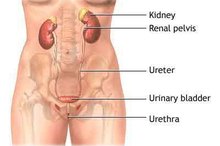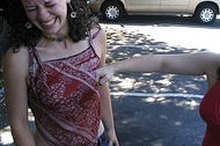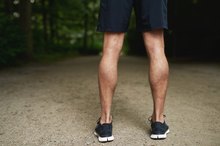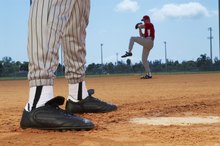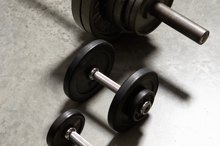Can You Pull Muscles in Your Breast?
The breasts are made up of glandular material surrounded by fatty tissue and encased by skin. They are attached to the chest wall by ligaments. The breasts rest on and are supported by the pectoralis major muscles. There is no muscle tissue in the breast itself, so it is not possible to pull a muscle in the breast. You can, however, damage the ligaments or the muscles that support the breasts.
Types
Pulled muscles, including those that support the breast, fall into three types or degrees of damage. First degree pulls involve less than 5 percent of the muscle mass and typically generate some pain and restriction of motion. Second degree pulls are usually referred to as partial muscle tears. There is considerable pain and restriction of range of motion. Third degree muscle pulls are complete tears across the muscle tissue. These tears involve great pain, the inability to contract the muscle and internal bleeding. Surgery may be required to repair third degree muscle tears.
- Pulled muscles, including those that support the breast, fall into three types or degrees of damage.
- First degree pulls involve less than 5 percent of the muscle mass and typically generate some pain and restriction of motion.
Identification
What to Do With a Pulled Groin on a Woman?
Learn More
A pulled pectoral muscle can be identified by minor to severe pain in the area of the pull 1. There is frequently bruising and swelling at the site. A pulled pectoral muscle often results in a loss of both mobility and strength.
Considerations
The pectoral muscles are not usually associated with pulls or tears because of their location on the body. Pulls are much more likely to occur in the muscles of the limbs such as the biceps or calf. However, overwork by activities such as weight lifting (or even lifting a child), or a blunt force trauma such as may occur during a car wreck, can cause a pulled pectoral muscle.
Treatment
How Long Does It Take a Torn Muscle to Heal?
Learn More
When you notice a pulled pectoral muscle, stop whatever activity you were doing that caused the pain. Begin immediate first aid treatment by applying an ice pack to the injured area. Wrap a compression bandage around the chest for support and contact your health care provider to assess the severity of the pull and for further professional treatment.
Warning
Continued exercise will only make the damage to the pectoral muscles worse by increasing internal bleeding. Massaging the damaged area may cause additional trauma to the already damaged muscle. Do not apply heat during first aid as this can also increase the flow of blood.
- Continued exercise will only make the damage to the pectoral muscles worse by increasing internal bleeding.
- Massaging the damaged area may cause additional trauma to the already damaged muscle.
Related Articles
References
- The Disabled List: How to treat a torn pectoral muscle
- Sports Doctor Inc.: The Painful Pull
- Manske RC, Prohaska D. Pectoralis major tendon repair post surgical rehabilitation. N Am J Sports Phys Ther. 2007;2(1):22-33.
- Roddey, T. S., Olson, S. L., & Grant, S. E. (2002). The effect of pectoralis muscle stretching on the resting position of the scapula in persons with varying degrees of forward head/rounded shoulder posture. Journal of Manual & Manipulative Therapy, 10(3), 124-128.
Writer Bio
Mike Parker is a full-time writer, publisher and independent businessman. His background includes a career as an investments broker with such NYSE member firms as Edward Jones & Company, AG Edwards & Sons and Dean Witter. He helped launch DiscoverCard as one of the company's first merchant sales reps.
